|
Gordon William McClain: From the Phonograph Era to the Radio Era
© Arthur E. Zimmerman and Betty Minaker Pratt
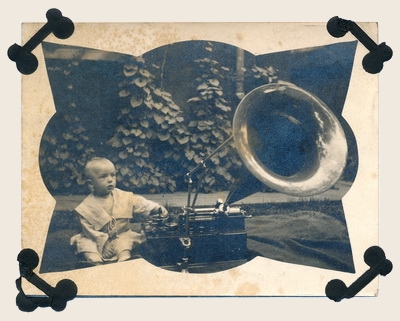
|
|
Gordon McClain, aged about one year, with an Edison Class M phonograph, c.1907. From
the G. W. McClain photo album.
(Photo courtesy of Arthur E. Zimmerman)
|
|
|
Several years ago, we found a scrapbook of family photographs and the framed “Certificate of Proficiency in Radiotelegraphy, First Class”, No. 978,
issued on June 16, 1924 to Gordon William McClain by the Canadian Department of Marine and Fisheries. On the back, there is a small portrait of McClain
and some particulars of his life. He was born in Toronto on March 20, 1906, was 5' 11", grey eyes, fair complexion and brown hair. Also on the back was
the stamp “CANCELLED 10.4.33".
We knew the name, since McClain had been a prominent wireless amateur in Toronto in the early 1920s. Most striking for us was the photo of a small child,
sitting in a garden beside an ancient North American Phonograph Company Class M machine, but there were also photos of young McClain wearing his scout
uniform, in his hamshack attic room with his elaborate wireless telegraphy (W/T) equipment, an Edison New Business Phonograph and his wireless telephone
or radiotelephone (AM radio) transmitter-receiver.
Several months later, Betty found an almost identical photograph of the child with the Class M. She discovered that Gordon McClain’s scrapbook and ephemeral
artefacts had been sold by an aged relative, and the collection had been broken up and sold in pieces. Apparently, our late colleague Wayne Plunkett had
ended up with some of the material, but its whereabouts are unknown.
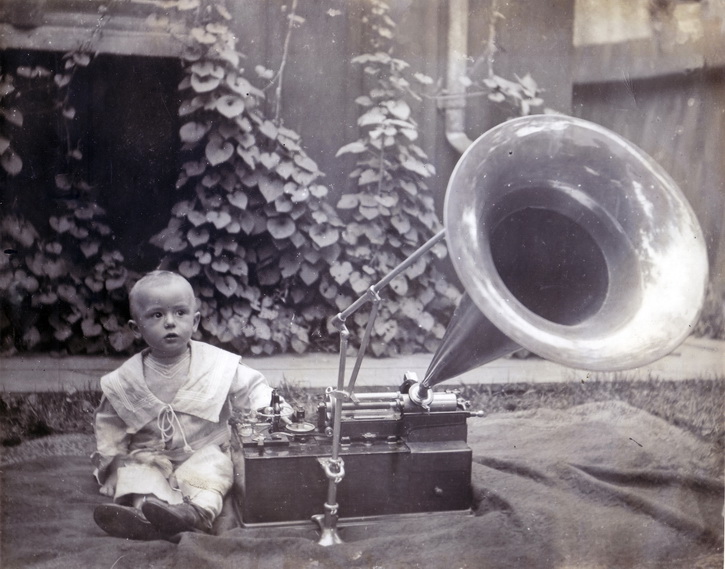
|
|
The infant Gordon William McClain, aged about a year, possibly in grandparents Wilkes’ back garden at 24 Bellevue
with a North American Phonograph Company Class M phonograph, circa summer 1907.
(Collection of Bill and Betty Pratt)
|
|
|
Gordon was the son of Thomas William McClain (b. 1879), a piano finisher, then piano maker and, by 1909, coal inspector for Toronto City Hall, and Caroline
Wilkes (1882-1955). The couple was married in 1903, lived at 96 Esther, then with the Wilkes at 24 Bellevue Avenue in 1907-08, to 295 St. Patrick, to 15
Division, moved to 542A Spadina Avenue in late 1911 and to 342 Brunswick Avenue, just north of Bloor Street West, in late 1918. The photos of young Gordon
and the Class M may well have been taken at 24 Bellevue in 1907.
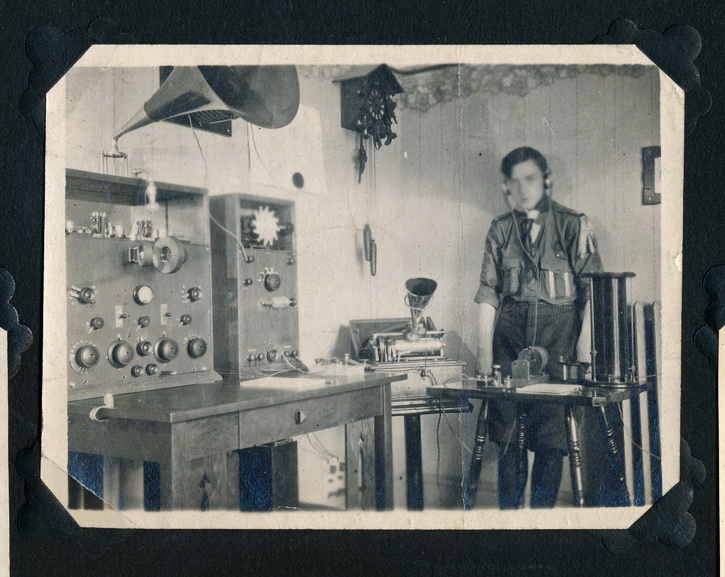
|
|
Boy scout Gordon W. McClain, in his hamshack in the attic of 342 Brunswick Avenue, possibly taken before he installed his radiophone equipment. At left is the
receiver with honeycomb coils on the front and the Marconi class II tubes for amplifying, topped by a gramophone horn. The saw-tooth rotary spark-gap apparatus
is at centre and he has an Edison Model D electric-driven New Business Phonograph with bullet-ended mandrel, original flattened aluminum recording horn and original
wire support. It has both a recorder and a reproducer head, takes 6-inch “Ediphone” shavable wax cylinders, and was possibly used for radiophone experiments in
broadcasting music and speech.
From the G.W. McClain photo album.
(Photo courtesy of Arthur E. Zimmerman)
|
|
|
We found no evidence that Gordon McClain had an official W/T licence before the Department of the Naval Service banned all amateur activity in 1917 through
the War Measures Act (WMA), but he said later that he had been actively engaged with W/T since the age of 9 (1). In 1915, like other unlicenced amateurs,
he might have used his own initials as his call or an invented X-call. He surely applied for his licence very soon after the WMA ban was lifted by the
Governor General in Council in mid-April and licences once again made available to amateurs by May 1, 1919.

|
|
An authentic Edison Model D Business Machine with bullet-ended mandrel, complete with original aluminum horn and wire horn-support.
(Photo courtesy of Jean-Paul Agnard and
Mark Caruana-Dingli)
|
|
|
The earliest listing that we found of McClain’s
call was as of May 1921, in the August edition of Canadian Wireless (2), from Department of the Naval Services lists, with 3GE at 342 Brunswick. The first
listing that we found of his Canada-wide experimental 9-call, 9CD, was in the “Official List of Radio Stations of Canada” of July 31, 1923.
By February 19, 1921, he had built, with his father’s help, one of the best home-made wireless outfits in the area, with a spark W/T and a radiotelephone.
With his 3-bulb audion, he had received signals from the Eiffel Tower, from Nauen in Germany, Carnarvon in Wales, Bermuda, San Francisco and even from Pearl
Harbor, Hawaii, and had invited a Toronto Star reporter to his attic “cabin” to hear a gramophone concert broadcast from the Marconi Company offices on King
Street, Toronto - Marconi’s announcer-operator was likely George Eaton - part of a weekly Tuesday night series that was run all of that winter. That Tuesday
night, Eaton played “I Love a Lassie” with Harry Lauder, “The Last Rose of Summer”, “Whispering”, “When I Dream of Old Erin”, plus two-steps and waltzes.
Gordon was able to amplify the audio signal by attaching a common gramophone horn to his radiotelephone, thus obviating the need for headphones.
Also that evening, McClain even picked up W/T from two Canadian government boats on the St. Lawrence. Some 130 local members of the Wireless Club of Ontario tuned in
to the Marconi concerts every Tuesday from 8 to a bit after 9 p.m., and their “shacks” were usually crowded with skeptical friends and neighbours.
The Star article described McClain’s equipment, his transmitting panel, with a 0.5 kW trans-former mounted on marble, a complete spark W/T apparatus and a radiophone.
A photograph of the wireless corner of McClain’s attic accompanied the article (3). In March, the same photo illustrated “Gordon W. McClain’s Station: This
Month’s Prize Winner” on page 610 of Radio News Magazine (4) as well as “Canadian 3GE, Toronto” in the American Radio Relay League magazine QST, out of New
Haven, Ct. (5).

|
|
The photograph of Gord McClain’s hamshack, as published in The Toronto Star, in QST and in Radio News in February and March, 1921. He had a 75-foot, 4-wire outdoor antenna,
but his indoor miniature aerial is visible on the ceiling at left. The marble transmitting switchboard, far left, holds meters and a 0.5 kW transformer with primary taps,
and on the table is a Signal glass-plate condenser variable by a fan switch, a saw-tooth variable-speed rotary spark-gap and a hinged pancake-type oscillation transformer.
For receiving, he has a unit with honeycomb coils, an electron relay detector and Marconi class II tubes for amplifying. Also a small crystal attachment for local reception.
The panel at extreme right is his radio telephone for AM receiving and transmitting. From the G. W. McClain photo album.
(Photo courtesy of Arthur E. Zimmerman)
|
|
|
Gordon McClain picked up the ends-of-quarters wirelessed reports of a Queen’s-Varsity football game in Kingston, broadcast from VBH, the Barriefield Marconi
shore station. McClain then phoned the scores in to Hart House, where they were posted (6; 7). That November, Canadian Wireless announced that 3GE’s receiver
had carried off the top prize at a recent wireless fair in Toronto (8).

|
|
Photo taken at the Ontario Wireless Association Conference in Toronto, published in The Toronto Star on October 2, 1922, showing “experienced radio fans who have
made their mark”, W.C Wood, left, Gordon W. McClain, centre, and E. S. “Ted” Rogers at right. McClain had held W/T conversations all over Ontario and into the U.S. and
Rogers was then the only Canadian amateur to be heard across the Atlantic.
From the G. W. McClain photo album.
(Photo courtesy of Arthur E. Zimmerman)
|
|
|
Another high point was when McClain, using his largely home-made equipment, received a special, scheduled radiophone greeting from the Kiwanians of Albany,
N.Y., to the Toronto group (9). He was often quoted by The Toronto Daily Star as having picked up their station’s broadcasts (10) and was reported putting
the horn of his amplifier out a window and The Star’s bedtime stories, political news and music were thus heard 400 feet north up his street (11).
That October, three top local radio experts were photographed at the Ontario Wireless Association Conference in Toronto, W.C. Wood, Gordon W. McClain and E. S. “Ted” Rogers (12),
all involved in Ontario regional W/T message relaying down the U.S. east coast.
The receiving set that attracted the most attention in the convention’s Daily Star
Amateur Tuner Contest was the efficient and artistic apparatus built by Gordon McClain, featuring 3 steps of A.F. amplification, a detector and 2 steps of audio
frequency (13). He also had the honour of being chosen by the magazine QST to announce by code and voice the offer of $100 in gold and a radio set to the first
person who could get in touch by wireless with station WMP, the Macmillan party in the Arctic (14).
In 1925, 19 year-old Gordon McClain was hired as remote control operator (for special location broadcasts) by Toronto radio station CKCL of the Dominion Battery
Company. In those days, CKCL was a “phantom station”, with no transmitter or frequency of its own, sharing time and a broadcast band with stations CFCA and CHIC.
Shortly thereafter, also in 1925, he was taken on as engineer and announcer by CFCA, The Toronto Star Station. An article by A.H.K. Russell (15) has a photo of
CFCA’s chief engineer Gord McClain at the microphone, in front of the new, up-to-date control set, finished in dull gold, which he had built himself. In the
photo, he is said to be receiving a remote broadcast of a football game by Foster Hewitt perched on the roof of Varsity Stadium. In March, 1928, CFCA aired the
Hambourg Society’s Super Broadcast with special guest Maurice Ravel from the Margaret Eaton Auditorium on McGill Street (16). That afternoon, CFCA had relayed
the sound of Big Ben’s chimes from 2LO, London, as well as a radio play.
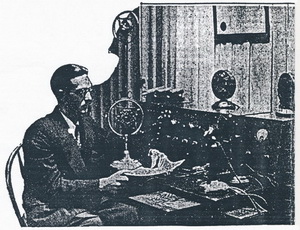
|
|
Publicity photo of chief announcer Gordon W. McClain at the microphone of The Toronto Star radio station, CFCA.
(TSW, Oct. 15, 1927, General Section, p. 1.)
|
|
|
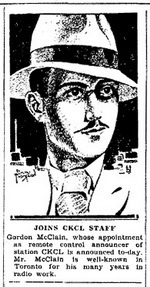
|
|
Gordon W. McClain (TDS, February 9, 1933, p. 26)
|
|
|
CFCA was also experimenting with television transmission and reception by early 1928 and one of their test broadcasts was a little piano recital by modernist
composer Henry Cowell of San Francisco, visiting the Hambourg Conservatory (17). The radio audience could hear the entire recital, while the few local television
viewers could both see and hear Mr. Cowell.
At 10:15 p.m. on August 19, 1928, CFCA received a broadcast from WGY, Schenectady, and sent out an audio translation of that video signal of a man plus an audio
signal of his voice. Foster Hewitt operated the speech input amplifiers at CFCA for re-transmission of the audio, while Charles Lowry of H.M. Kipp Co., received
the pictures as audio signals, forwarded them by land-line to CFCA for maximum amplification and the combined broadcast was picked up through a receiving dish
by CFCA’s chief engineer Gordon McClain at 342 Brunswick. There, the audio was translated into video and displayed on his experimental television receiving
apparatus. These experiments would continue at times through the week “together with CFCA’s television broadcasts” (18). A few days later, Aikenhead’s Hardware
Store on Temperance Street announced that they were stocking a television receiving kit, made by the Insuline Corporation, the same set as used by McClain for
the CFCA transmission (19).
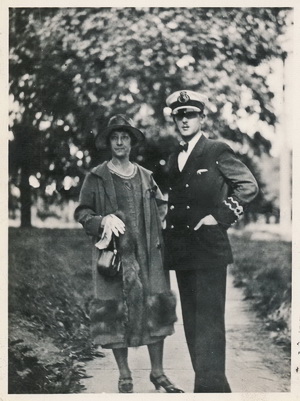
|
|
Officer G..W. McClain with his mother, undated, but post-1940. From the G.W. McClain photo album.
(Photo courtesy of Arthur E. Zimmerman)
|
|
|
Gord McClain was Chief Announcer at CFCA in 1930, as well as an actor with the Jane Gray Players on CFCA (20) and on CFRB (21). He also hosted and read poems on
a very popular 30-minute sacred program, “Hymns and Ballads”, that ran on CFCA for a year and a half, with Burton Till at the new studio organ (22).
Perhaps radio technology had advanced so quickly that McClain was slipping behind and he was demoted to Chief Announcer, MC-ing Jack Evans’ Orchestra season
farewell (23). He also personally directed The Community Institute of Radio Broadcasting in the Federal Building, slogan “Make Me a Star”, training natural
talents for radio broadcasting work (24). In early 1933, McClain was still in Toronto, doing occasional announcing (25). “Renowned for his radio work”, the
languishing McClain was appointed remote control announcer at CKCL, Toronto, on Feb. 9, 1933 (26).
A few months later, as one of three CKCL announcers, with Maurice Rapkin and Edward Guest (27), he became the jazz expert at CKCL, hosting its “Around the
Bandstand” contest (28). Former boy scout and scout master, he was the obvious choice to be at the CRCT microphone (Canadian Radio Broadcasting Commission) for
the broadcast of the Scouts’ Rally honouring Lord and Lady Baden-Powell (29). We found his letter to the editor of The Star congratulating the paper on the
dignified handling of the Radio Commission’s news of the death of King George V and the abrupt cancelling of all broadcasting throughout the Dominion (30).
A few months later two pioneers, McClain and baritone Gary Carter, premiered a new CRCT series with piano and organ (31). Gord McClain filled in as interim host
for CKCL’s “Saturday Swing Session” in July, 1936 (32), and the next day was announced as the host of a new CKCL program, “As We Like It”, discussing different
band leaders and their music (33) and interviewing celebrities, including Cab Calloway (34). Gord replaced Al Savage at CKCL, among other things doing race
reports in the afternoons (35).

|
|
Carbon copy of congratulatory telegram sent by G.W. McClain to Foster Hewitt on the opening of Foster's radio station CKFH in Toronto, circa February 1951.
From the G.W. McClain photo album.
(Photo courtesy of Arthur E. Zimmerman)
|
|
|
In July, he became Program Director at CHML, Hamilton (36). One of his capers with Perc Lesuere for “Mountain City” at 11:30 a.m., outside the CHML studio on
James Street, was to stand under a ladder, holding black cats and interview passers-by about superstitions (37). Another man-in-the-street show, “Vox Pop”,
drew a crowd and a policeman argued with McClain, on mike, to leave the street (38).
A few years later, he was briefly an announcer at CKTB, St. Catharines, Ontario, then at CKPR, Fort William in 1939 (39). In the 1940 Canada Voters List, he
was listed as a radio engineer, living with his parents at 342 Brunswick Avenue.
Gordon W. McClain joined the Royal Canadian Signal Corps at Camp Borden in January, 1940, as signal officer for the tank corps (39) and Lieut. McClain, signal
officer, was featured in a Globe photo montage of a “mimic battle” in the Barrie-Oshawa vicinity in August 1940 (40). He was sent overseas in 1942, returned as
a captain in 1944 and was appointed to the Canadian Army Film and Photo Unit (CFPU) at Merton Park, London, supervising production of the weekly Canadian Army
newsreels, special documentaries and theatrical shorts (41). There is a photo of him with the CFPU, screening the last edition of their films, #106, on January
20, 1946 (42, 43). Unfortunately, there is no indication of whether McClain may have been the voice on the later CFPU newsreels.
Back on civvy street in Toronto by spring of 1946, he was setting up as a freelance writer and producer, reported as visiting the offices of Canadian Broadcaster (41).
In the 1949 Canada Voters List, he was shown as an editor, living in #23, 540 Lakeshore Avenue, in 1950 as a radio editor at CBC, in 1953 as an army officer
(Permanent Forces), living with his parents at 342 Brunswick, as a member of the Permanent Forces in 1955, in the 1963 list as a civil servant at 46 Summerhill Gardens,
Toronto. In 1972, the last time we found him, he was retired and living in 31E at 10 Tichester Road, Toronto. The old family home, 342 Brunswick, was listed in August 1973,
offering newly furnished and broadloomed rooms for rent (44).
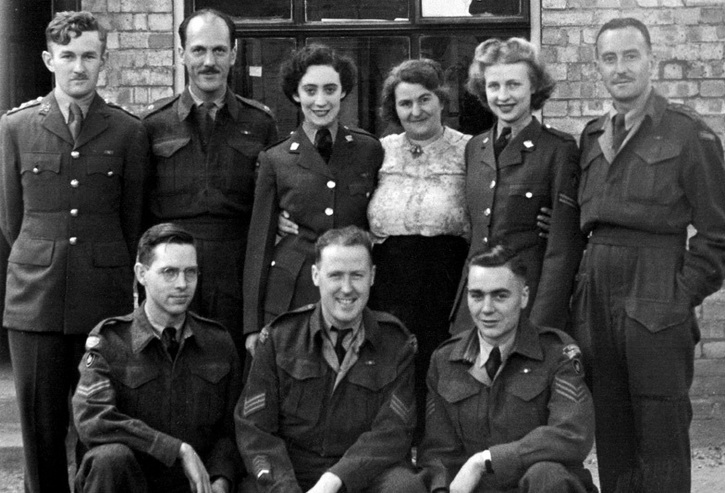
|
The crew of the CFPU at the Merton Park studio, undated. Back row: L to R: Capt. Michael Spencer, Maj. Gordon Sparling, Sgt. Nadine Manning, Mrs. Moffat, Cpl. Marjorie Cox and Capt.
Gordon McClain. Front row, L to R: unidentified, Sgt. Lew Weekes and Sgt. Ken Ewart. (From Canadian Film & Photo Unit and Dale Gervais)
|
|
|
In conclusion, from a family album and his 1924 “Certificate of Proficiency in Radiotelegraphy”, we were able to work out the life trajectory of infant phonograph
enthusiast Gordon William McClain, working in the media: from scouting to W/T and radio telephony, into early commercial radio in Toronto as engineer, announcer and
disc-jockey, pioneering in experimental television with CFCA, using his W/T expertise in signals training in WW II, being hired by the team producing military newsreels
and documentaries with the CFPU, returning home to be a radio editor at CBC and finally working for the government.
References
TDS — Toronto Daily Star
TSW — Toronto Star Weekly
G — Toronto Globe and Mail
- TDS, October 18, 1934, p. 28
- Canadian Wireless, Vol. 1 #3, August, 1921, p. 4, published by Scientific Experimenter, a subsidiary of the Marconi Wireless Telegraph Company of Canada, Ltd., Montreal.
In the first edition of the Official List of Broadcasting Stations in Canada, April, 1921, G.W. McClain at 342 Brunswick Avenue had certificate number 151, the call 3GE
and was registered to operate at 50 metres.
- TDS, February 19, 1921, page 20.
- Radio News Magazine, March 1921, p. 610.
- QST, March 1921, p. 43, the magazine of the Ameri-can Radio Relay League, New Haven, Ct.
- Toronto Varsity, October 10, 1921, p. 1.
- "In the Shadow of the Shield: The Development of Wireless Telegraphy and Radio Broadcasting in Kingston and at Queen's University.
An Oral and Documentary History, 1902-1957" by Arthur E. Zimmerman (self-published, 1991), p. 149.
- Canadian Wireless, Vol. 1 #6, November 1921, p. 7.
- TDS, April 4, 1922, page 7.
- TDS, April 13, 1922, p. 60.
- TDS, April 17, 1922, p. 7.
- TDS, October 2, 1922, page 7.
- TDS, September 12, 1922, p. 24.
- TDS, May 12, 1924, p. 5.
- TSW, October 15, 1927, General Section, p. 1.
- TDS, March 23, 1928, p. 35.
- TDS, March 2, 1928, p.29.
- TDS, August 20, 1928, p. 9.
- TDS, August 23, 1928, p. 32.
- TDS, August 26, 1930, p. 24.
- TDS, September 17, 1930, p. 22.
- TDS, November 21, 1931, p. 20.
- TDS, May 19, 1932, p. 28.
- TDS, October 1, 1932, p. 22.
- TDS, January 17, 1933, p. 20.
- TDS, February 9, 1933, p. 26.
- TDS, August 2, 1933, p. 31.
- TDS, October 18, 1934, p. 28.
- TDS, May 3, 1935, p. 28.
- TDS, January 23, 1936, p. 5.
- TDS, March 1, 1936, p. 20.
- TDS, July 3, 1936, p. 20.
- Ibid., p. 18.
- TDS, May 10, 1937, p. 24.
- TDS, November 2, 1936, p. 12.
- TDS, July 13, 1937, p. 20.
- G, August 13, 1937, p. 14.
- TDS, September 18, 1937, p. 22.
- Broadcasting / Broadcast Advertising, August 15, 1940, p. 79.
- G, August 12, 1940, p. 11.
- Canadian Radio Yearbook, 1946, p. 82; Canadian Broadcaster, May 4, 1946, p. 9.
- "War Through the Lens: The Canadian Film and Photo Unit, 1941-1945" by Dan Conlin (Seraphim Editions, Niagara Falls, Ontario, 2015, page 127).
- "The War Amps presents The Canadian Army Newsreels, filmed and Produced by the Canadian Army Film Unit, 106 newsreels on 6 DVDs; Scarborough, Ontario.
- TDS, August 24, 1973, p. D9.
Our thanks to Dale Gervais, Film Conservator at Library & Archives Canada, for his help with the CFPU, to Bill Pratt, Allen Koenigsberg, Mark Caruana-Dingli and
Jean-Paul Agnard for identifying the Edison Business phonograph and to Bill Pratt for invaluable discussions, for improving and cropping the photographs and for his
kind assistance with text editing.
|